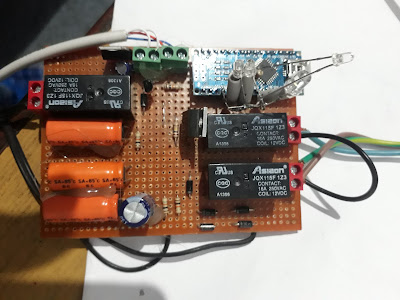Some time when we forget to switch off the submersible pump then the upper tank water will be overflow until we get noticed. or some time in a middle of a bath the tank water get empty . and every day we need to switch and carefully switch off the motor after the tank get filled even we dont know how much water in the tank.
so I design this Automatic water level controller
I use Arduino nano in this project and wright a program and upload in it.
Use a ultra sonic sensor for sensing water level . i fix the sensor in the lid of water tank and connect the control box with a 4 core cable.
the control board has arduino nano and color LED 's for the water level
the red led for indicating water level below 10%
amber LED indicate water above 25%
yellow is above 50%
green is above 75 %
when the water level goes below 10% the the ultra sonic sensor sense that level and arduino code check the main voltage. if it normal decide to switch on the pump through a relay for a second this is parallel to the start button of manual pump starter switch.
when the motor is running a long beep sound here once and a blue LED blinking.
after the water level reach above 90% the arduino switch a relay for a second witch switch of the manual stop button. and gives a short beep
the current water level always show in the device
and again the water reach a level lower than 10 % the motor start again automatically.
the pump can run manually also OFF at any time .even the this water controller is on .
NB:before use this device for the first time the tank level should be calibrated once and put the value in the Program and I updated the code.
The device work very good but the Hot water vapor formed inside the tank make the ultrasonic sensor failure. So I remove the normal Sensor and use a water proof utrasonic sensor and the problem solved.
future plan: i want to update this project with OLD Display for water level indication.
and also use Solid state pump control circuit instead of relays .
also use wireless to connect sensor and the device.


Comments
Post a Comment